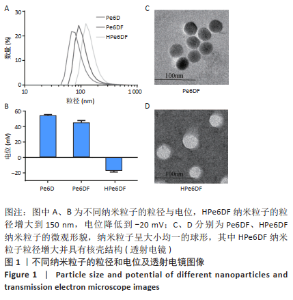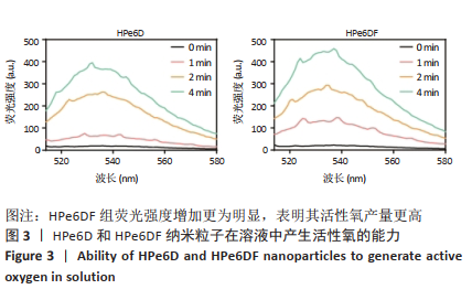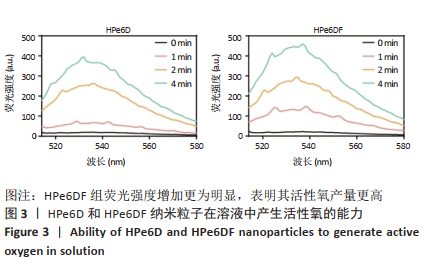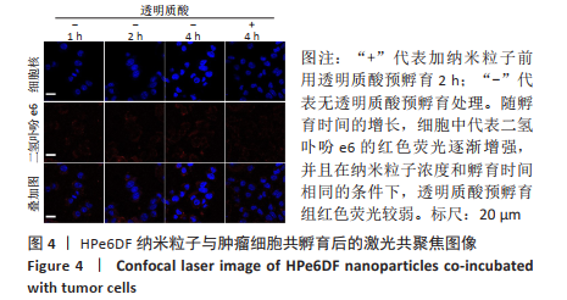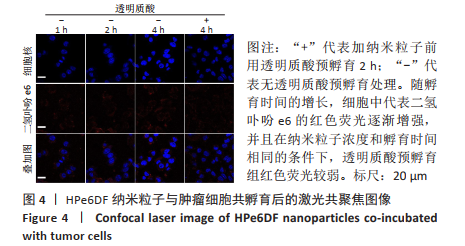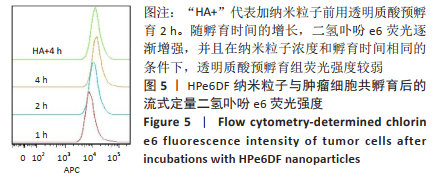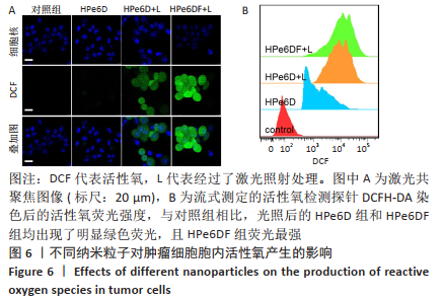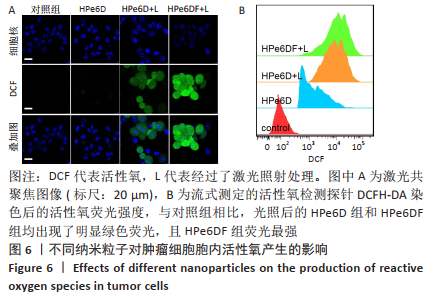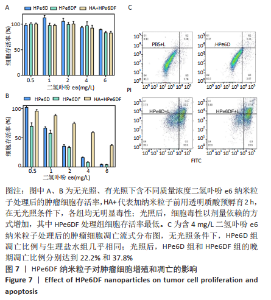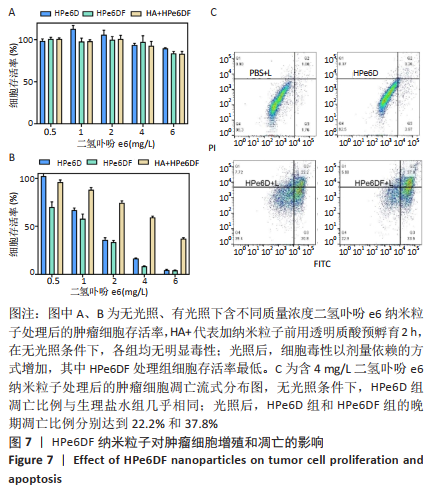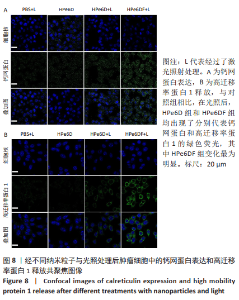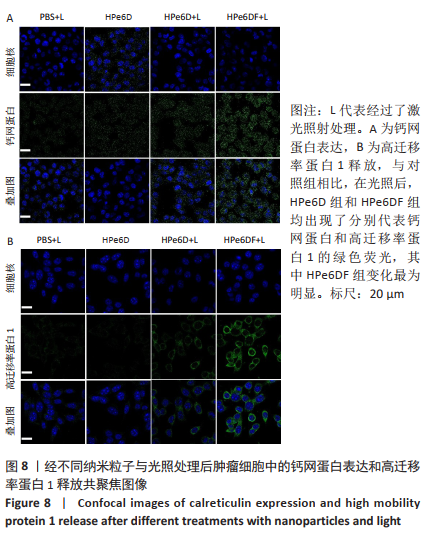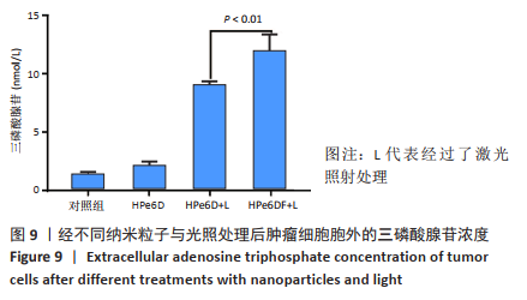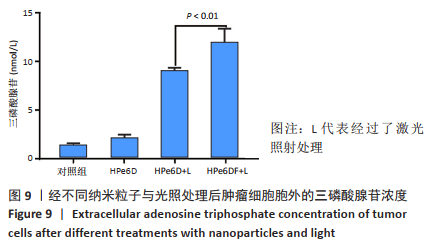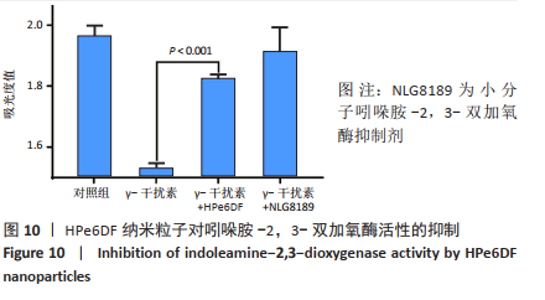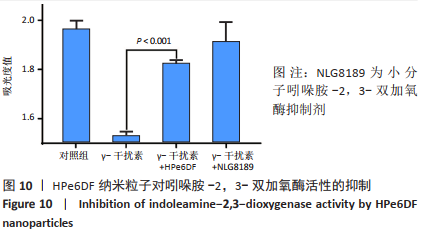Chinese Journal of Tissue Engineering Research ›› 2022, Vol. 26 ›› Issue (10): 1566-1573.doi: 10.12307/2022.205
Previous Articles Next Articles
Prepared HPe6DF composite nanoparticles enhance the effect of photodynamic therapy
Cai Shengsheng, Mei Heng, Zhang Xuequan, Deng Jin, Cao Jun, He Bin
- National Engineering Research Center for Biomaterials, Sichuan University, Chengdu 610064, Sichuan Province, China
-
Received:2021-05-07Revised:2021-05-11Accepted:2021-06-16Online:2022-04-08Published:2021-10-27 -
Contact:Cao Jun, Researcher, National Engineering Research Center for Biomaterials, Sichuan University, Chengdu 610064, Sichuan Province, China -
About author:Cai Shengsheng, Master candidate, National Engineering Research Center for Biomaterials, Sichuan University, Chengdu 610064, Sichuan Province, China -
Supported by:National Key Research and Development Program of China, No. 2017YFB0702603 (to CJ)
CLC Number:
Cite this article
Cai Shengsheng, Mei Heng, Zhang Xuequan, Deng Jin, Cao Jun, He Bin. Prepared HPe6DF composite nanoparticles enhance the effect of photodynamic therapy[J]. Chinese Journal of Tissue Engineering Research, 2022, 26(10): 1566-1573.
share this article
Add to citation manager EndNote|Reference Manager|ProCite|BibTeX|RefWorks
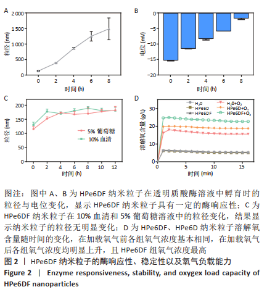
图2A、B为HPe6DF纳米粒子与透明质酸酶(100-250 U/mL)共同孵育不同时间的粒径和电位变化图,从图中可以看出,随着时间的增加,HPe6DF纳米粒子的粒径和电位均逐渐增加,表明其具有一定的透明质酸酶响应性。图2C是HPe6DF纳米粒子孵育在体积分数10%血清和5%葡萄糖溶液中粒径随时间的变化曲线,从图中可以看出,随着培养时间的延长,HPe6DF纳米粒子在体积分数10%血清和5%葡萄糖溶液中孵育时粒径几乎未发生变化,电位测试结果也保持正常波动。图2D是不同样品中的溶解氧含量随时间变化,从图中可以看出,在加载氧气前各组氧气浓度基本相同,在加载氧气后各组氧气浓度均明显上升,且HPe6DF组氧气浓度最高。由紫外和高效液相色谱分别检测了二氢卟吩e6和NLG8189的载药量,二者的载药量分别为11.84%和5.41%。"
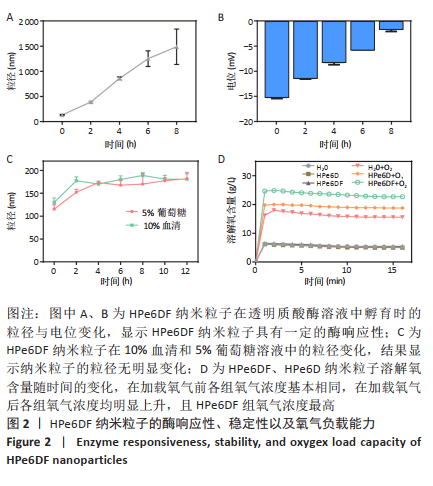
| [1] CUI D, HUANG J, ZHEN X, et al. A Semiconducting Polymer Nano-prodrug for Hypoxia-Activated Photodynamic Cancer Therapy. Angew Chem Int Ed. 2019;58(18):5920-5924. [2] KWIATKOWSKI S, KNAP B, PRZYSTUPSKI D, et al. Photodynamic therapy-mechanisms, photosensitizers and combinations. Biomed Pharmacother. 2018;106:1098-1107. [3] YUAN Y, ZHANG CJ, GAO M, et al. Specific Light-Up Bioprobe with Aggregation-Induced Emission and Activatable Photoactivity for the Targeted and Image-Guided Photodynamic Ablation of Cancer Cells. Angew Chem Int Ed. 2015;54(6):1780-1786. [4] WANG X, LI J, LI L, et al. Photodynamic Therapy-Induced Apoptosis of Keloid Fibroblasts is Mediated by Radical Oxygen Species In Vitro. Clin Lab. 2015;61(9):1257-1266. [5] ZHAO H, XING D, CHEN Q. New insights of mitochondria reactive oxygen species generation and cell apoptosis induced by low dose photodynamic therapy. Eur J Cancer. 2011;47(18):2750-2761. [6] SUN Y, ZHAO D, WANG G, et al. Recent progress of hypoxia-modulated multifunctional nanomedicines to enhance photodynamic therapy: opportunities, challenges, and future development. Acta Pharm Sin B. 2020;10(8):1382-1396. [7] ZHANG K, ZHANG Y, MENG X, et al. Light-triggered theranostic liposomes for tumor diagnosis and combined photodynamic and hypoxia-activated prodrug therapy. Biomaterials. 2018;185:301-309. [8] ZHANG X, WU M, LI J, et al. Light-Enhanced Hypoxia-Response of Conjugated Polymer Nanocarrier for Successive Synergistic Photodynamic and Chemo-Therapy. ACS Appl Mater Interfaces. 2018; 10(26):21909-21919. [9] SHI C, LI M, ZHANG Z, et al. Catalase-based liposomal for reversing immunosuppressive tumor microenvironment and enhanced cancer chemo-photodynamic therapy. Biomaterials. 2020;233:119755. [10] ZHU W, DONG Z, FU T, et al. Modulation of Hypoxia in Solid Tumor Microenvironment with MnO2 Nanoparticles to Enhance Photodynamic Therapy. Adv Funct Mater. 2016;26(30):5490-5498. [11] CHEN S, HUANG B, PEI W, et al. Mitochondria-Targeting Oxygen-Sufficient Perfluorocarbon Nanoparticles for Imaging-Guided Tumor Phototherapy. Int J Nanomed. 2020;15:8641-8658. [12] TIAN J, ZHANG W. Polydopamine-Loaded Fluorinated Hyaluronic Acid (HA) Photosensitizer Nanoparticles for Synergetic Photodynamic and Photothermal Therapy of Hypoxic Tumors. Huadong Ligong Daxue Xuebao. 2019;45(2):285-292. [13] WANG Y, ZHANG F, LIN H, et al. Biodegradable Hollow MoSe2/Fe3O4 Nanospheres as the Photodynamic Therapy-Enhanced Agent for Multimode CT/MR/IR Imaging and Synergistic Antitumor Therapy. ACS Appl Mater Interfaces. 2019;11(47):43964-43975. [14] JI J, FAN Z, ZHOU F, et al. Improvement of DC vaccine with ALA-PDT induced immunogenic apoptotic cells for skin squamous cell carcinoma. Oncotarget. 2015;6(19):17135-17146. [15] LARISCH P, VERWANGER T, LINECKER M, et al. The interrelation between a pro-inflammatory milieu and fluorescence diagnosis or photodynamic therapy of human skin cell lines. Photodiagn Photodyn Ther. 2014;11(2):91-103. [16] CHEN PW, UNO T, KSANDER BR. Tumor escape mutants develop within an immune-privileged environment in the absence of T cell selection. J Immunol. 2006;177(1):162-168. [17] LANG K, ENTSCHLADEN F, WEIDT C, et al. Tumor immune escape mechanisms: impact of the neuroendocrine system. Cancer Immunol Immunother. 2006;55(7):749-760. [18] VILLALBA M, RATHORE MG, LOPEZ-ROYUELA N, et al. From tumor cell metabolism to tumor immune escape. Int J Biochem Cell Biol. 2013; 45(1):106-113. [19] CRAMER GM, MOON EK, CENGEL KA, et al. Photodynamic Therapy and Immune Checkpoint Blockade(dagger). Photochem Photobiol. 2020;96(5):954-961. [20] HWANG HS, CHERUKULA K, BANG YJ, et al. Combination of Photodynamic Therapy and a Flagellin-Adjuvanted Cancer Vaccine Potentiated the Anti-PD-1-Mediated Melanoma Suppression. Cells. 2020;9(11):2432. [21] ZHANG Y, LIAO Y, TANG Q, et al. Biomimetic Nanoemulsion for Synergistic Photodynamic-Immunotherapy Against Hypoxic Breast Tumor. Angew Chem Int Ed. 2021;60:10647-10653. [22] MALACHOWSKI WP, METZ R, PRENDERGAST GC, et al. A new cancer immunosuppression target: indoleamine 2,3-dioxygenase (IDO). A review of the IDO mechanism, inhibition and therapeutic applications. Drugs Futur. 2005;30(9):897-909. [23] QIAN S, ZHANG M, CHEN Q, et al. IDO as a drug target for cancer immunotherapy: recent developments in IDO inhibitors discovery. RSC Adv. 2016;6(9):7575-7581. [24] ZHANG H, LIU W, LIU Z, et al. Discovery of indoleamine 2,3-dioxygenase inhibitors using machine learning based virtual screening. Medchemcomm. 2018;9(6):937-945. [25] GAO A, CHEN B, GAO J, et al. Sheddable Prodrug Vesicles Combating Adaptive Immune Resistance for Improved Photodynamic Immunotherapy of Cancer. Nano Lett. 2020;20(1):353-362. [26] LIU D, CHEN B, MO Y, et al. Redox-Activated Porphyrin-Based Liposome Remote-Loaded with Indoleamine 2,3-Dioxygenase (IDO) Inhibitor for Synergistic Photoimmunotherapy through Induction of Immunogenic Cell Death and Blockage of IDO Pathway. Nano Lett. 2019;19(10): 6964-6976. [27] GUO Y, JIANG K, SHEN Z, et al. A Small Molecule Nanodrug by Self-Assembly of Dual Anticancer Drugs and Photosensitizer for Synergistic near-Infrared Cancer Theranostics. ACS Appl Mater Interfaces. 2017; 9(50):43508-43519. [28] XIAO Y, AN FF, CHEN J, et al. The impact of light irradiation timing on the efficacy of nanoformula-based photo/chemo combination therapy. J Mater Chem B. 2018;6(22):3692-3702. [29] ZHU T, SHI L, YU C, et al. Ferroptosis Promotes Photodynamic Therapy: Supramolecular Photosensitizer-Inducer Nanodrug for Enhanced Cancer Treatment. Theranostics. 2019;9(11):3293-3307. [30] KADLECOVA Z, RAJENDRA Y, MATASCI M, et al. DNA delivery with hyperbranched polylysine: A comparative study with linear and dendritic polylysine. J Controlled Release. 2013;169(3): 276-288. [31] LV P, ZHOU C, ZHAO Y, et al. Modified epsilon-polylysine-grafted-PEI-beta-cyclodextrin supramolecular carrier for gene delivery. Carbohydr Polym. 2017;168:103-111. [32] WANG SJ, BOURGUIGNON LYW. Hyaluronan-CD44 promotes phospholipase C-mediated Ca2+ signaling and cisplatin resistance in head and neck cancer. Arch Otolaryngol Head Neck Surg. 2006;132(1): 19-24. [33] GAO SG, ZHANG MX, ZHU XJ, et al. Apoptotic effects of Photofrin-Diomed 630-PDT on SHEEC human esophageal squamous cancer cells. Int J Clin Exp Med. 2015;8(9):15098-15107. [34] TU PH, HUANG Q, OU YS, et al. Aloe-emodin-mediated photodynamic therapy induces autophagy and apoptosis in human osteosarcoma cell line MG-63 through the ROS/JNK signaling pathway. Oncol Rep. 2016;35(6):3209-3215. [35] XUE Q, WANG P, WANG XB, et al. Targeted inhibition of p38MAPK-enhanced autophagy in SW620 cells resistant to photodynamic therapy-induced apoptosis. Lasers Med Sci. 2015;30(7):1967-1975. [36] DENG H, ZHOU Z, YANG W, et al. Endoplasmic Reticulum Targeting to Amplify Immunogenic Cell Death for Cancer Immunotherapy. Nano Lett. 2020;20(3):1928-1933. [37] ALZEIBAK R, MISHCHENKO TA, SHILYAGINA NY, et al. Targeting immunogenic cancer cell death by photodynamic therapy: past, present and future. J Immunother Cancer. 2021;9(1):e001926. [38] DOIX B, TREMPOLEC N, RIANT O, et al. Low Photosensitizer Dose and Early Radiotherapy Enhance Antitumor Immune Response of Photodynamic Therapy-Based Dendritic Cell Vaccination. Front Oncol. 2019;9:811. [39] GARG AD, DUDEK AM, FERREIRA GB, et al. ROS-induced autophagy in cancer cells assists in evasion from determinants of immunogenic cell death. Autophagy. 2013;9(9):1292-1307. [40] WU D, FAN YY, YAN HH, et al. Oxidation-sensitive polymeric nanocarrier-mediated cascade PDT chemotherapy for synergistic cancer therapy and potentiated checkpoint blockade immunotherapy. Chem Eng J. 2021;404:126481. |
| [1] | LIU Danni, SUN Guanghua, ZHOU Guijuan, LIU Hongya, ZHOU Jun, TAN Jinqu, HUANG Xiarong, PENG Ting, FENG Wei-bin, LUO Fu. Effect of electroacupuncture on apoptosis of neurons in cerebral cortex of rats with cerebral ischemia-reperfusion injury at "Shuigou" and "Baihui" points [J]. Chinese Journal of Tissue Engineering Research, 2022, 26(在线): 1-6. |
| [2] | Jin Tao, Liu Lin, Zhu Xiaoyan, Shi Yucong, Niu Jianxiong, Zhang Tongtong, Wu Shujin, Yang Qingshan. Osteoarthritis and mitochondrial abnormalities [J]. Chinese Journal of Tissue Engineering Research, 2022, 26(9): 1452-1458. |
| [3] | Wen Dandan, Li Qiang, Shen Caiqi, Ji Zhe, Jin Peisheng. Nocardia rubra cell wall skeleton for extemal use improves the viability of adipogenic mesenchymal stem cells and promotes diabetes wound repair [J]. Chinese Journal of Tissue Engineering Research, 2022, 26(7): 1038-1044. |
| [4] | Zhang Yujie, Yang Jiandong, Cai Jun, Zhu Shoulei, Tian Yuan. Mechanism by which allicin inhibits proliferation and promotes apoptosis of rat vascular endothelial cells [J]. Chinese Journal of Tissue Engineering Research, 2022, 26(7): 1080-1084. |
| [5] | Huang Chenwei, Fei Yankang, Zhu Mengmei, Li Penghao, Yu Bing. Important role of glutathione in stemness and regulation of stem cells [J]. Chinese Journal of Tissue Engineering Research, 2022, 26(7): 1119-1124. |
| [6] | Deng Shuang, Pu Rui, Chen Ziyang, Zhang Jianchao, Yuan Lingyan . Effects of exercise preconditioning on myocardial protection and apoptosis in a mouse model of myocardial remodeling due to early stress overload [J]. Chinese Journal of Tissue Engineering Research, 2022, 26(5): 717-723. |
| [7] | Lin Zhiyu, Han Jie, Ren Guowu, Chai Yuan, Wen Shuaibo, Wu Yukun, Xie Xiaozhong, Jin Wanqing. Active components of flemingia in regulating the signaling pathways related to knee osteoarthritis [J]. Chinese Journal of Tissue Engineering Research, 2022, 26(36): 5889-5896. |
| [8] | Zhou Liang, Chen Xingzhen, Li Zhenyu, Zhang Zekun, Duan Guoqing. The mechanism of lncRNA HOTAIR in interleukin-1beta-mediated osteoarthritis [J]. Chinese Journal of Tissue Engineering Research, 2022, 26(35): 5607-5613. |
| [9] | Wu Yongli, Liu Di, Wang Duo, Liu Junwei, Ma Yuyuan. Effect of warm acupuncture on PI3K/Akt signaling pathway in articular cartilage of a rabbit knee osteoarthritis model [J]. Chinese Journal of Tissue Engineering Research, 2022, 26(35): 5596-5601. |
| [10] | Liu Danni, Sun Guanghua, Zhou Guijuan, Liu Hongya, Zhou Jun, Tan Jinqu, Huang Xiarong, Peng Ting, Feng Weibin, Luo Fu. Effect of electroacupuncture at Shuigou and Baihui acupoints on neuronal apoptosis in cerebral cortex of rats with cerebral ischemia-reperfusion injury [J]. Chinese Journal of Tissue Engineering Research, 2022, 26(35): 5620-5625. |
| [11] | Fan Yongfu, Su Kaiqi, Yuan Jie, Nie Chenchen, Ruan Xiaodi, Duan Zhaoyuan, Feng Xiaodong. Relationship between iron metabolism and ischemic stroke [J]. Chinese Journal of Tissue Engineering Research, 2022, 26(32): 5223-5228. |
| [12] | Zhang Lili, Ou Ya, Yuan Xiaodong, Zhang Pingshu. Bax/Bcl-2 protein and apoptosis during adipose-derived stromal cell differentiation into astrocytes [J]. Chinese Journal of Tissue Engineering Research, 2022, 26(31): 4982-4987. |
| [13] | Wei Hewei, Zheng Weipeng, Liu Zhijun, Zhao Guoyuan, Fang Weihua, Chen Sheng, Liao Zhihao, Wan Lei. Expression of autophagy in rotator cuff tendon stem cells induced by oxidative stress [J]. Chinese Journal of Tissue Engineering Research, 2022, 26(31): 4954-4961. |
| [14] | Wang Kang, Zhi Xiaodong, Zhang Yuqiang, Gong Chao, Wang Chenliang, Wang Wei. Human amniotic epithelial cells regulate the proliferation, apoptosis and extracellular matrix synthesis of articular chondrocytes by activating the EGFR/ERK1 signaling axis [J]. Chinese Journal of Tissue Engineering Research, 2022, 26(31): 4967-4974. |
| [15] | Zheng Meijie, Yang Weizhe, Liu Jialin, Han Xiangzhen, Zhou Qiqi, He Huiyu. Apoptosis of mouse bone marrow-derived macrophages induced by lipopolysaccharide [J]. Chinese Journal of Tissue Engineering Research, 2022, 26(31): 4962-4966. |
| Viewed | ||||||
|
Full text |
|
|||||
|
Abstract |
|
|||||
